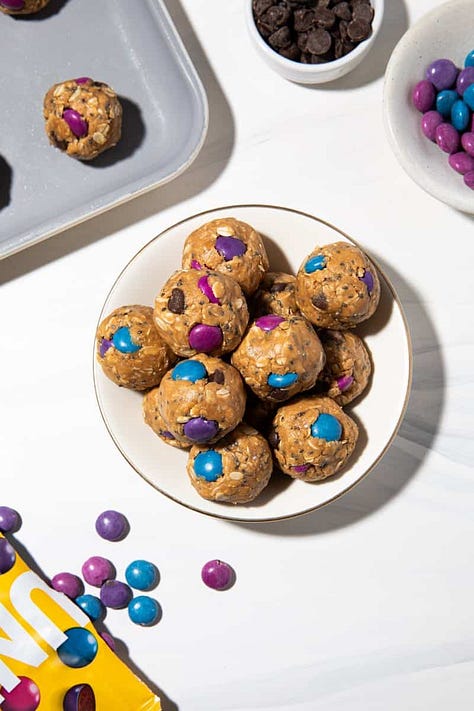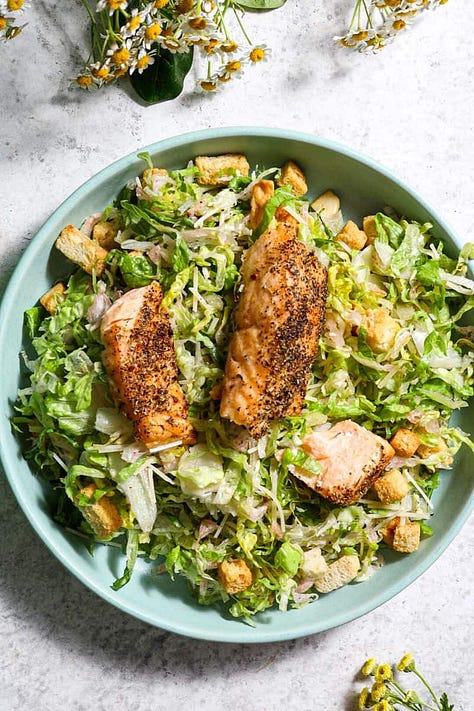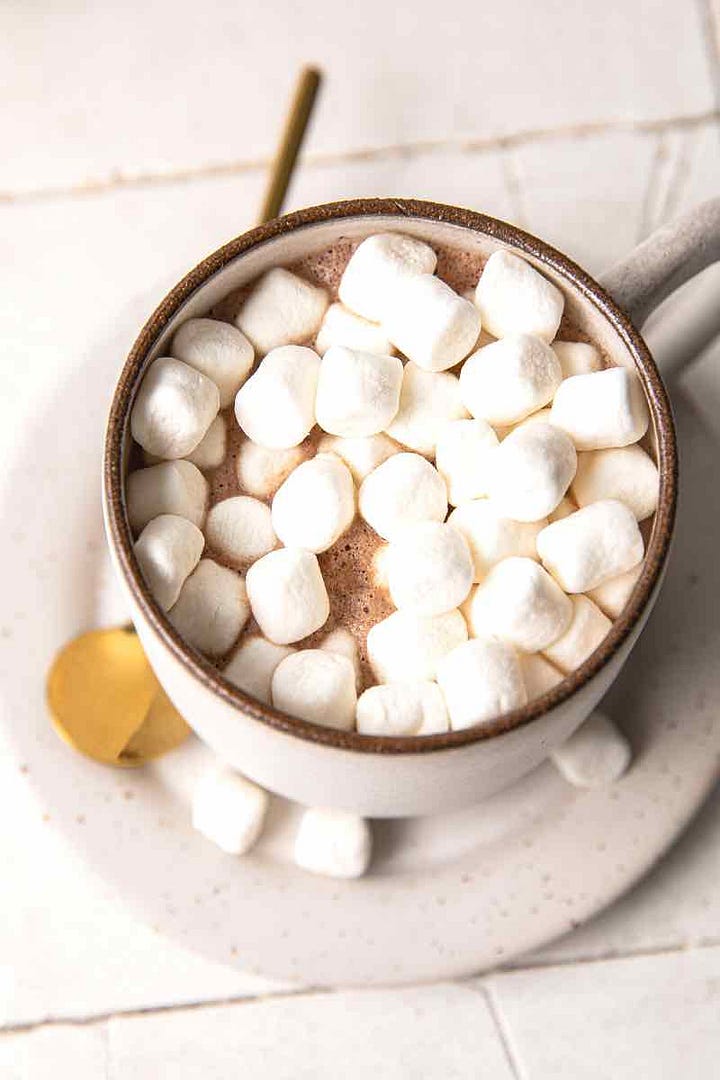Macro Tracking Without the Overwhelm: A Balanced Approach to Eating Enough
How I use macro tracking as a tool for nourishment (not punishment) and make it easy to stick with while healing, plus tips for newbies from my personal trainer & meal prep inspo for the week ahead.
I’ve had a love-hate relationship with counting macros for as long as I can remember. My first introduction to tracking food and macros came from a diet-culture-fueled mindset, which led to more unhealthy habits than anything else. When I was healing my gut from SIBO, my functional practitioner encouraged me to count macros again to ensure I was hitting my protein goals. But honestly? I was too scared of falling back into old habits and too overwhelmed by the healing process to add one more thing to my plate. So instead, I did my best to eat as much protein as possible each day and just hoped it was enough.
It wasn’t until early 2022, when I started working out with my trainer, Chris, that I gave macro tracking another shot. Nick and I had just joined his gym, AussieFit HQ, and Chris reintroduced me to tracking macros. Admittedly, I was terrified—but I was also willing to try again with his guidance. To my surprise, it wasn’t nearly as overwhelming as I had feared, and I credit that largely to Chris’s approach.
Now, lucky for us, Chris has agreed to answer a few key questions for macro-tracking newbies so you can get started on your own at home! But first I want to share more about my personal experience.
My Current Experience with Macro Tracking
Before we get into the details of why tracking macros can be helpful, I want to share my personal experience with it—because my approach now is vastly different from when I first started over 10 years ago. My hope is that my progress will inspire you to see macro tracking as a tool for nourishment, not punishment.
Right now, my goal is fat loss—but due to my autoimmunity, chronic inflammation, and the lingering effects of post-COVID viral overload, this has been an uphill battle. I have never worked so hard at something and seen such little progress in my life. It’s been frustrating, humbling, and eye-opening. But it has also taught me so much about how our bodies work and what they actually need.
You’ve heard me talk non-stop about the importance of protein and slowing down, and this is exactly why I’m so passionate about those topics. My body needs rest and nourishment more than anything right now, and the best way I know how to ensure I’m giving it one of those things is by tracking my macros—not as a way to force fat loss, but as a way to make sure I’m actually eating enough.
I’ve always been a chronic under-eater. If I don’t have my meals prepped and planned, I forget to eat, I get overwhelmed by too many choices, and before I know it, I’m under-fueling my body (aka stressing it out) without even realizing it.
How I Make Macro Tracking Easier
To avoid that, I plan out all my meals, snacks, and even desserts for the entire week on Saturday before heading to the grocery store. Then, on Sunday, I prep everything—and while I’m meal prepping, I log every single meal for the week into my macro tracking app.
Now, I know what you’re thinking.
"There’s no way in fresh hell I’m taking the time to meal prep AND log everything into an app ahead of time. She’s crazy!"
I get it. It sounds like a lot.
But I promise you—it will simplify your life in ways you didn’t even know were possible.
Since you’re already weighing, measuring, and prepping your food, all you have to do is pop the recipe into an app like MyFitnessPal and let it do the math for you. Then, you can plug your meals in for the entire week so you’ll know exactly what you’re eating and when you’re eating it.
Personally, I like to keep things super simple:
✔️ Same lunch all week
✔️ Same dinner all week
✔️ Variety in my breakfasts and snacks
At first, I worried that eating the same meals all week would be boring, but instead, it has streamlined my entire day. I no longer waste time wondering what to eat—I just check my app, grab my meal from the fridge, heat it up, eat, and move on.
And the best part?
I no longer:
❌ Get stuck in the “What do you want to eat?” cycle
❌ Stare into the fridge hangry AF, grabbing random snacks
❌ Struggle to hit my protein goals
Instead, I feel satisfied, energized, and—most importantly—nourished. And because I’m eating enough protein daily, my body finally feels safe enough to start the healing process.





Ready to Get Started?
Whether you’re brand new to macro tracking or looking to get back into it after some time away, I asked Chris a few key questions that will help make the process easier for you. His expert tips are below!





What are macros, and why do they matter? Macros are 3 categories that your calories are broken down to - Protein, Carbs and Fats. From a personal coaching perspective, they help my clients understand WHAT they are eating. Knowledge of even approximate macros can help people make better food decisions for whatever their goal is (fat loss, sports performance, balance etc). Food is fuel, and by understanding what is in our fuel sources we can optimise our nutrition for body composition, health and performance (mental and physical!)
How can someone calculate their macros, especially protein goals, without a coach? I usually use apps like MyFitnessPal but encourage clients to look at nutritional values on the back of packaging (or Google it!). When it comes to specific goals, this is very goal dependant - but in the case of general body composition and strength training Protein is key. I recommend 1-1.5grams of protein per lbs of desired body weight.
How accurate do you need to be? Should people weigh their food? I operate under “Close enough is good enough!” Ballparking your macros is a decent method, once you have weighed/tracked your food for a period of time and have a decent comprehension of what’s in what.
What are common mistakes beginners make when counting macros? Definitely underestimating macros and calories, or leaving out beverages/additives like cooking oil and sauces!
Do you have to track macros forever, or can you transition to intuitive eating? Knowledge of macros can lead to intuition, but to truly hit the mark you should track for at least a few months. I personally don’t count my macros anymore - I just count my protein to make sure I’m getting enough and track my calories (ballpark) so I’m in a deficit for fat loss or surplus for growth(aka bulking). I guess you could say a hybrid split of macros and intuition is a great recipe for success.
What happens if someone goes over or under their macros one day? As I briefly touched on above, I don’t believe macros are the be all and end all for most goals. I used to be a macro diehard! But as I’ve grown as a coach my methods have changed personally and for gen pop folks. If you really nail your overall calories and your protein count, the carbs and fats typically fall into place.
What I’m Meal Prepping This Weekend:
If you need a little inspo, here’s a look at some of the meals & treats I’m planning on meal prepping for the week ahead.
Air Fryer Salmon. This is one of my favorite recipes to prep because it takes under 10 minutes and can be used for fresh or frozen salmon fillets. Looking for a fun way to enjoy your air fryer salmon? Try this Salmon Caesar Salad for lunch!
Air Fryer Smashed Potatoes. Another amazing air fryer recipe that makes the perfect side for salmon at dinner. I also love eating them for breakfast with some scrambled eggs & breakfast sausage.
Monster Cookie Energy Bites. One of my newest protein dessert recipes, these Monster Cookie Energy Bites are the perfect no
bake treat to meal prep! If you’re in the mood for some baking, I’d suggest making these Protein Banana Bread Cookies - they’re INSANE!
Protein Hot Chocolate. Ok so this one I don’t actually prep ahead, but I DO make this every single night of the week during the winter to help hit my protein goals, satisfy my chocolate cravings, and be cozy all at once.
Let me know if you find this helpful or have any other questions about protein, meal prep or macro tracking!
xoxo
Kim



